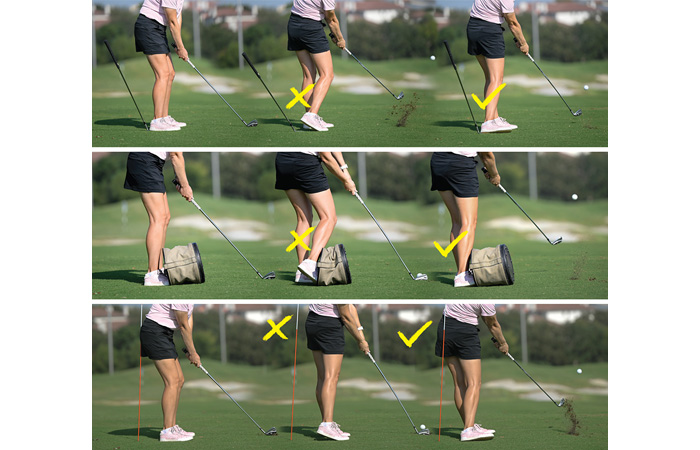There are many faults that can cause a shank; rather, it is a setup issue or a swing technique issue. Below I demonstrate a couple of the swing technique faults that cause shanks and drills to eliminate that dreaded “S” word from your game.
A common fault I see when people shank the ball is their pelvis and trail knee move toward the golf ball on the downswing, causing the hosel of the golf club to get closer to the ball causing the shank. If this is your tendency, here are a couple drills to help you gain consistency hitting the ball in the center of the clubface and the direction you want.
Grab an old wedge if you have one and place the clubhead under your trail heel, practicing hitting shots not allowing the club to fall to the ground until after you make impact with the ball. In order for the club to not fall to the ground, your pelvis cannot move toward the golf ball and your trail heel must stay on the ground. The club can fall to the ground after you make contact with the ball, but not prior.
The bucket drill is probably one of my all-time favorite drills if you struggle with how your lower body moves on the downswing.

Place your trail foot inside a bucket, leaving a ¼-½ inch space between the lip of the bucket and your trail shin. Hit some half swing shots, not allowing your trail shin to hit the lip on the bucket. In order for your trail shin to not hit the bucket, your pelvis and trail knee must stay back. At impact, weight shifts from the ball of your trail foot into your lead heal, not into your trail toes. Another way to think of it is your trial knee moves toward your lead knee at impact and the follow-through almost kissing your lead knee, rather than moving toward the golf ball and finishing with space between your knees on your follow-through.
Another common fault is early extension. This refers to when your hips move toward the golf ball in the downswing, and one stands up getting out of posture. Just as with the “sliding” issue above, it has the effect of cramping you through impact and forcing the hosel to lead into the ball. Sometimes those who early extend lack core strength. Having strength in your core helps to maintain posture throughout the swing. Performing some simple golf core exercises should help.
You can do this drill on the driving range or at home without a club. If you do this at home, stand upright with your butt against a wall, then take your normal golf stance and posture having your butt against the wall at address (if you are doing this at the range, place an alignment stick behind you). Now practice making swings or hitting balls, ensuring your butt is staying against the wall or alignment stick through impact. If you tend to move your hips toward the ball, this drill will highlight it. This drill will quickly give you a sense for what it feels like to stay in your posture.
Another fix for the dreaded shank is path. If your club path is too much out-to-in, it can cause the shank. Here is a simple drill to see if this is the reason why you are shanking the ball.
For this drill, place an object ½ inch outside of the ball and if you hit the object your path is too out-to-in, causing you to hit shanks or slices. Practice hitting shots without hitting the object.
For more tips and information on instruction, reach out to me at 972-399-9040 or kpikegolf@gmail.com